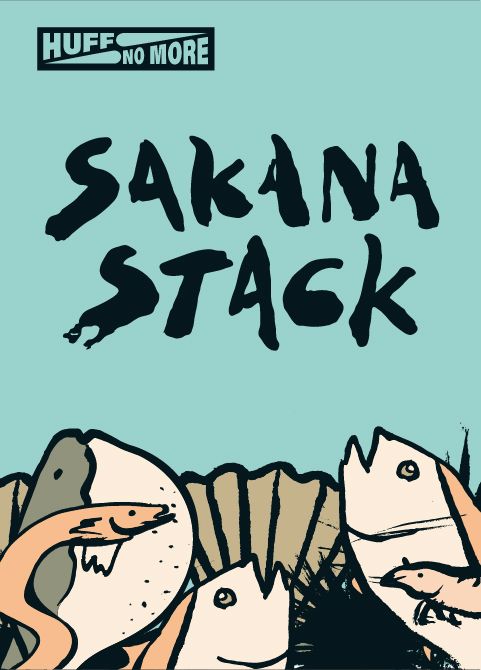Sakana Stack is another of those games with a theme that sounds cute, but ultimately turns into a game of numbers, much like Scout (read my review of Scout here). What it also has in common with Scout is that it is an easy-to-grasp card game that is a lot of fun, plays quickly, and has a lot of layers.
Sakana Stack is set in the famous Tsukiji fish market in Japan, hence the name Sakana, which translates as fish. The idea of the game is that each player is trying to sell their catch to prospective customers, but in order to attract them to your fish instead of your competitors’, you need to put out the best stack of seafood. How does this translate to a card game? Well, each card has a value and a suit. The suits are colours and represent different types of fish; pufferfish, eel, scallops etc.

On your turn you need to place a stack of cards down. Each of the cards has to have the same value. If there’s another stack on the table though, you need to obey a couple of rules. Firstly, you need to follow suit or number. Secondly, you need to equal or beat the value of the other stack. That’s the core of the game, and while there are a few other things to consider (like being able to use the Catch of the Day card on top of the draw pile), understanding those concepts is all you need to get started.
Play the player
It only takes a round or so of Sakana Stack to get it. Once you understand how it works mechanically, you can start to work on your tactics, and there’s a lot of scope for tactical play. Right from your first turn, you have a lot of choices to make. In a game where you want to get rid of all of your cards as quickly as you can, it can be tempting to slap down all four of those 7s you’ve got in your hand. However, you might want to do just enough to beat the current stack and play just a couple of them, ensuring you have some higher-value cards left to play later.

Slapping down a stack with a value of 28 though, that’s powerful. Remember, the other players need to follow suit or value and at least equal the stack value. If you can’t do that you have to take that Catch of the Day card from the top of the draw deck into your hand, and the owner of the stack(s) on the table takes the top card of that stack and flip it face-down as a scoring card. Points for each round are based on how many cards you manage to score.
Despite my mini-grumble at the top about a lack of theme, you can kinda see it here. You can picture people continuously trying to one-up each other’s stacks of fish, and when one finally concedes (i.e. you can’t follow with a high enough value), the winning player is selling part of their catch, scoring points in the process. I mean, a card game like this is never going to win awards for the strongest theme implementation, but it still does it well. Let’s be honest though, nobody is buying a small card game for the theme. They live and die on how much fun they are and how much replayability they pack in.
Sakana Stack manages to tick both those boxes.
Final thoughts
I first came across Sakana Stack at this year’s UKGE, where I fell in love with the artwork. I didn’t get a chance to speak to the folks behind the desk, so I was delighted when Mike from Huff No More got in touch to see if I wanted to cover the game. I only had two niggles when I started playing the game. Firstly, I found the rules explanation a little hard to understand from the sheet included in the box. Bear in mind that this is still a preview copy of the game, and it’s likely that things will change between now and the final release of the game. Once you understand it though, it’s a breeze.
The second niggle is more of a personal thing, and that’s that I like it when a small game caters for two players too. When Sakana Stack landed on my doormat it was advertised as 3-5 players, which isn’t the end of the world, but a niggle nonetheless. But this is where playing with previews of games sometimes throws unexpected things your way, and this time it was Mike sending me a message to let me know the two-player rules have been added to the game. Nice! They work really well too, but I still prefer the game with four or five people. I like the fact that it takes longer for your turn to come around, and harder to score your own stack as points, which happens if it comes back to you and you have a stack in front of you.
It looks like the campaign (which you can keep track of here) is going to launch at about £14 for the game, which is a no-brainer as far as I’m concerned. I’ve had more play out of this than I have some games that cost twice as much. Sakana Stack is quick, easy, gorgeous to look at, and a lot of fun. It’ll join the likes of Scout and Tokkuri Taking (review here) in my convention bag for some time to come. Great stuff.
Preview copy kindly provided by Huff No More. Thoughts and opinions are my own.
Enjoying this article? Consider supporting me.

Sakana Stack (2025)
Design: Mike Petchey
Publisher: Huff No More
Art: Joss Petchey
Players: 2-5
Playing time: 15-30 mins


